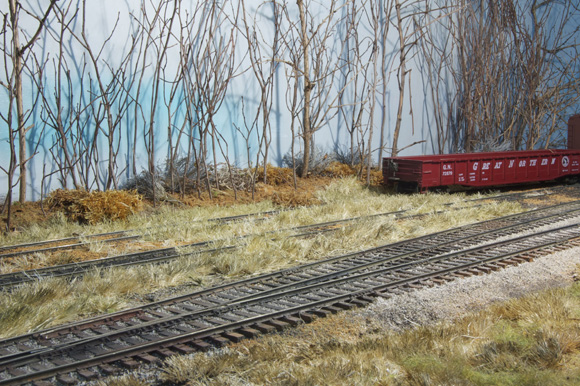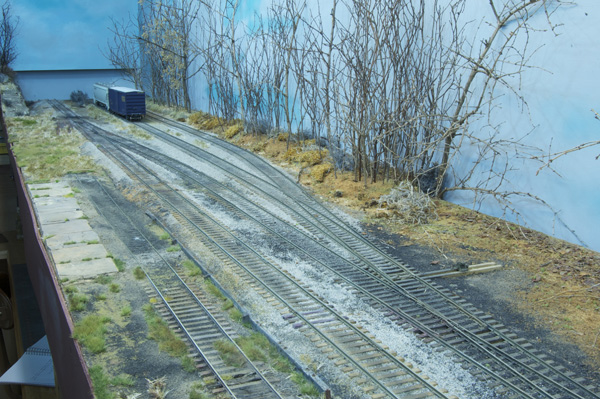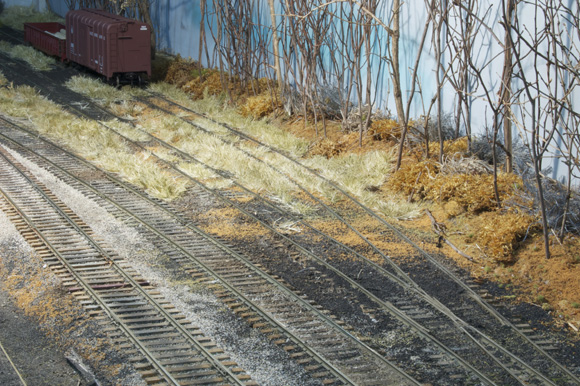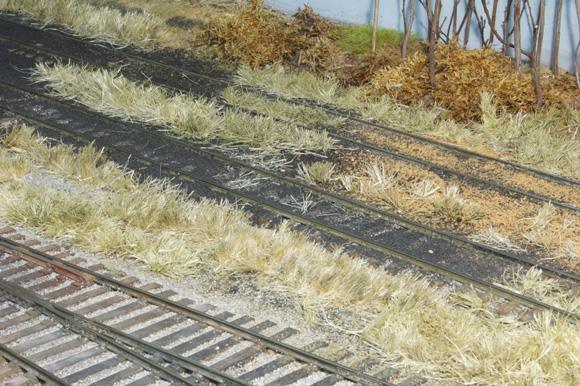I’ve been busy with development work for the company, so just a short update or two this week.
Weeding the yard
Scenery progress along the CSX interchange is shaping up nicely. To refresh your memory, here’s what I started with and then how it looks today.
Both tracks have been reballasted with cinders and weeds are steadily growing along the back track. Soon it’ll be time to work on the area next to the backdrop. Admittedly, my method of using sisal twine for weeds is labor intensive to the max. My friend Trevor Marshall gets amazing results on his Port Rowan layout in a fraction of the time with a static grass applicator (see the post “Interview With Trevor Marshall” for photos of his layout). Given the expense of these tools and the nearly completed state of the I&W, purchasing one now is impossible to justify.
- My routine for using the twine is to do small sections over time. It’s a simple matter to lay down some glue and apply a few weeds in odd moments during the day. The process is easy to start and stop at will and, good progress will be made with persistence. The color of the raw twine is toned down with color washes from Doctor Ben’s Scale Consortium. I use his Realistic Oak (#1081), Natural Pine (#1082) and Aged Driftwood (#1080) stains.
This area is much improved and now blends in better with the rest of the layout. On page 27 of our book Detailing Track, there is a photo taken on the East Broad Top in 1976, that shows a similar weedy effect.

I made the weeds between the tracks quite tall to separate them from each other and the foreground of the scene.
New book
The landscape book is also well underway. Chapters one and two are all but complete. I don’t want to say too much at this point because these projects tend to change radically throughout the creative process. I will share this however, most of the existing literature centers on techniques: how to model grass, landforms, and such. Sort of like a recipe book for cooking. Gather these ingredients, mix accordingly, bake and let cool before serving. Techniques are certainly important but not the whole story.
Our book will be more like a set of blueprints for scenery. Like the blueprints for a house, the book will show the big picture along with the individual details and how they all fit together. No date for publication yet, it’s still too early in the process. Just know that things are moving forward. There are other goodies in the pipeline too and word will be coming on those in due time. For now, back to work.
Regards,
Mike



Mike:
The weeds and grass look great – congrats on the apparent lack of revenue-generating business on the layout (grin!)
I’m sure you’ll have many people ask how the trains actually run through all of that. I know that’s the question I get when they see the grass on my layout. The answer, of course, is “just fine”. Tweaking scenery is like tweaking track – little bits of work add up and at some point it all works just fine.
Thanks for continuing to push against conventional thinking in this great hobby!
– Trevor
Hi Trevor,
Yes I had to do some trimming around the track, for smooth operation. The taller weeds were rubbing against the side frames of the trucks oddly enough. Electrical contact hasn’t been much of an issue. As for pushing against conventions, you haven’t seen anything yet.
Regards,
Mike
Mike,
The “new” scene looks great, why not put the stump of a tree at the end of the storage track closest to the backdrop. One of those little guys that starts to grow and before the track gang knows it, a weed has become a tree!
Matt
Hi Matt,
Do you and Trevor coordinate your responses? 😉
He suggested the same thing. Great minds apparently.
Yes, I do plan to add some saplings and small trees at the end of the track. They will help hide the corner. I’m going to park a heavily weathered gondola car back there, with the saplings growing up around it, maybe even growing through a hole in the rotted floorboards! That would be a sight.
Regards,
Mike